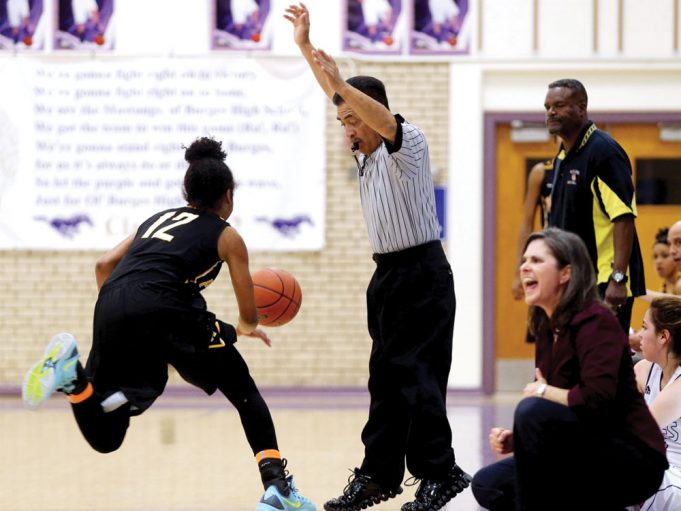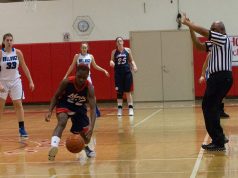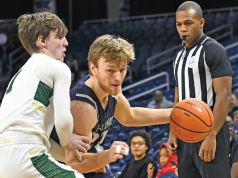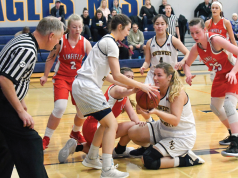M
ost everyone knows, in the game of basketball, when the ball touches a boundary line or anything outside the boundary line, it is out of bounds and play is stopped by a whistle from the official. But what happens if a player leaves the court during live play? If you do not already know, the answer to that question depends on several factors.
Let us start with the first and most obvious situation, which is written in the NFHS and NCAA rulebooks under rule 9-3. Though the verbiage and circumstances are slightly different between the levels, the basic premise is the same. If a player leaves the court by voluntarily stepping out of bounds, he or she has committed a violation. If you are reading the NFHS rulebook, it ends just like that. There are no other possibilities or additional explanation to negate this violation. The simple action of leaving the court for an unauthorized reason is final and should be considered a violation of the rule as it is written. If you are holding either of the NCAA rulebooks in your hands, there is a bit more to it. The NCAA rule explains a player who merely steps out of bounds has not committed a violation unless that player is the first player to touch the ball after returning to the court.
It is important to note, when referencing the reason a player leaves the court, “under their own volition” in college or “for an unauthorized reason” in high school, they both mean the same thing. For this action to be illegal, the player must leave the court “voluntarily.” So, when players make the conscious decision to go out of bounds, either to create an advantage for themselves or to put their defenders at a disadvantage, they are leaving the court voluntarily and therefore are then subject to possible penalty by the game officials. Let us go over an example of what would qualify.
Play 1: Two players for team A set a double screen near the endline. A1, using the screen in an effort to lose a defender, intentionally runs around the screen in the out-of-bounds area behind the basket and returns to the playing court on the other side just beyond the three-point arc. After stepping back onto the court A1 is the first to receive a pass, shooting the ball for a successful three-point goal. Ruling 1: According to NFHS rule 9-3-3, a violation occurred and a whistle should be sounded the moment A1 stepped out of bounds. According to NCAA rule 9-3.1, since A1 stepped out of bounds voluntarily, the moment A1 first touched the ball after returning to the court, a violation occurred.
As many may remember, not too long ago, the penalty for leaving the court voluntarily was a very harsh technical foul, but that has since changed to a kinder, more palatable sentence and is only ruled a violation. Once the whistle is sounded, the ball becomes dead and the usual procedure for a violation is followed, resuming play with the ball being awarded to the opponents of the violating team for a throw-in nearest the spot of the violation (NFHS 7-5-2; NCAAM 7-3.2; NCAAW 7-4.1).
OK, so now we know how to handle plays when a player runs out of bounds of his or her own volition, but what if said player does not purposely go out? What if the player is bumped out, or better yet, what if the player is running so hard to save a ball from going out of bounds that his or her momentum carries the player off the court? And what if after coming back in and establishing inbound status, that player is the first to touch the ball again? When we reference the rulebooks at all levels, there is no direct wording prohibiting an accidental or unintentional exit of the playing court, therefore suggesting any action causing a player to “go out” involuntarily would be legal.
Many officials do not like to go on “assumptions” and find it hard to accept a one-size-fits-all ruling on plays that do not have explicit language telling them such. Luckily, those officials do have that luxury in this “unwritten” rule. The casebook in each of the three respective rules codes has a scenario that explains this exact type of play.
Play 2: A1 deflects a pass near the endline. The ball falls to the floor inbounds but A1, who is off balance, steps off the court. A1 returns inbounds, secures control of the ball and dribbles. Ruling 2: This is a legal play because A1 did not leave the playing court voluntarily nor in control of the ball when entering the out-of-bounds area. The rules also state similar actions are legal, such as a player attempting a layup under the basket and missing, and even though the player’s momentum carries the player off the court, it would be legal to return and regain control (NFHS 7.1.1 B; NCAAM A.R. 165; NCAAW A.R. 197).
Remembering all these scenarios and special stipulations may seem to be a daunting task, so to help keep it all straight to rule on these plays properly, ask yourself this one question: Did the player go out of bounds purposely or not? If the player stepped outside of the boundary lines of the playing court with intent to gain an advantage or put the opponent at a disadvantage, the player’s action should be considered voluntary. But if the player simply ran out of bounds accidentally, or because momentum from a hustle play forced the player out, there is no intent of wrongdoing and such action should be ruled legal.
The next time you see this type of play when you are on the court, if you can successfully answer this one question, you should get the call right every time.
What's Your Call? Leave a Comment:
Note: This article is archival in nature. Rules, interpretations, mechanics, philosophies and other information may or may not be correct for the current year.
This article is the copyright of ©Referee Enterprises, Inc., and may not be republished in whole or in part online, in print or in any capacity without expressed written permission from Referee. The article is made available for educational use by individuals.


















